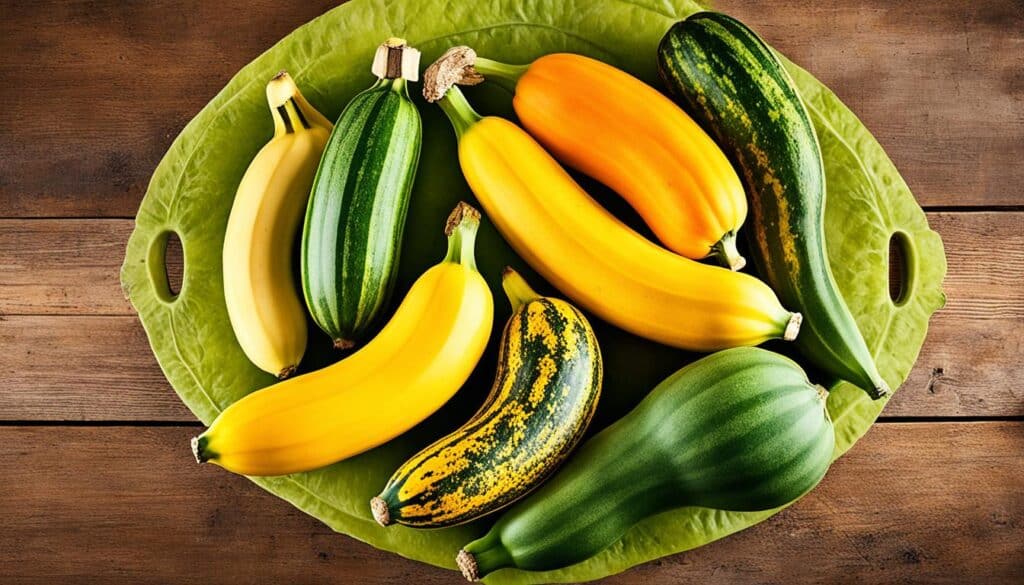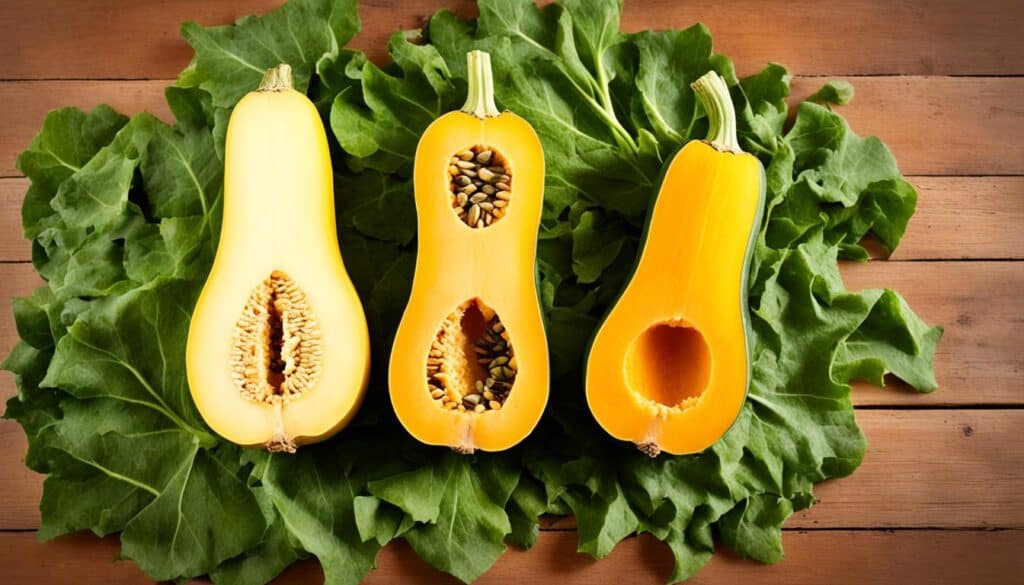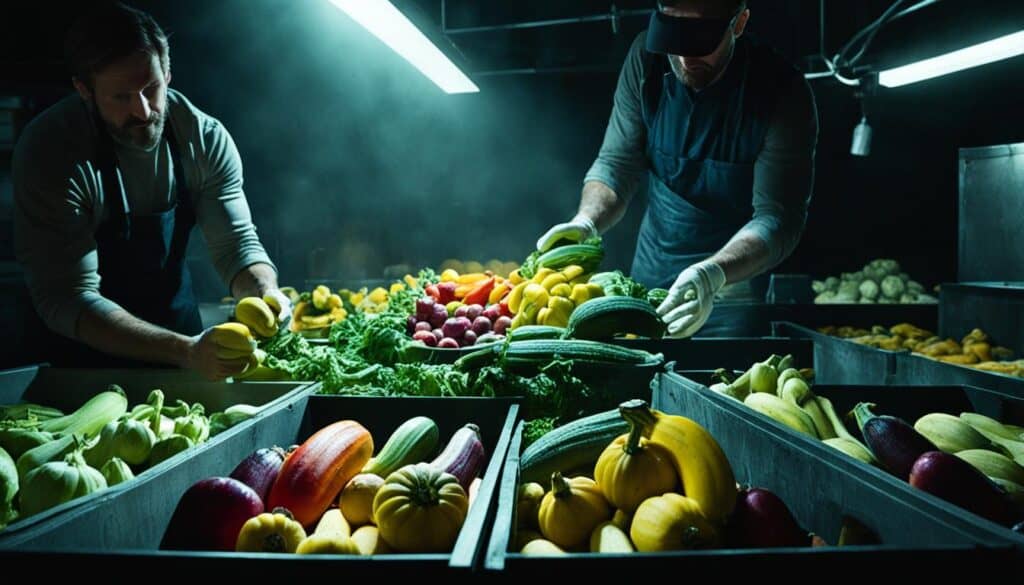Did you know that banana squash, a versatile winter squash, offers a range of delicious recipes and numerous health benefits? From mouthwatering soups to delectable pancakes, banana squash can be the star ingredient in your kitchen. In this article, I will share tips on how to cook banana squash, provide some tantalizing recipes, discuss its nutritional value, and even guide you on how to grow your own. Get ready to explore the world of banana squash and elevate your culinary skills!
Key Takeaways:
- Banana squash is a versatile winter squash that can be used in various delicious recipes.
- Cooking banana squash is simple, whether you choose to bake, roast, or sauté it.
- There are numerous mouthwatering recipes to try with banana squash, including soups, noodles, and pancakes.
- Banana squash is low in calories, high in fiber, and packed with essential nutrients.
- You can grow your own banana squash in your garden with the right conditions and care.
How to Cook Banana Squash
Cooking banana squash is a simple process that can be enjoyed by beginners and experienced cooks alike. To prepare this versatile winter squash, follow these easy steps:
- Wash the banana squash to remove any dirt or debris.
- Cut off any bad spots on the squash using a sharp knife.
- Slice the squash into 3-inch sections. This will make it easier to handle and cook.
- Remove the seeds from the squash using a spoon or your fingers.
- Scrape out the excess stringy meat from the sections using a spoon.
- Remove the outer skin of the squash using a vegetable peeler or a knife.
- Decide on your preferred cooking method:
If you prefer baking, cut the squash into smaller, bite-sized pieces. Add butter, spices, and sweeteners of your choice, such as cinnamon and brown sugar. Wrap the prepared squash tightly in aluminum foil. Bake it in the oven at 375°F for about 1 hour and 15 minutes or until tender.
Baking the squash allows it to become soft and caramelized, enhancing its natural sweetness. The addition of butter and spices adds flavor and depth to the dish.
Alternatively, you can explore other cooking methods:
- Roasting: Cut the squash into wedges or cubes, toss them in olive oil, salt, and pepper, then roast at 400°F for approximately 30-40 minutes until golden and tender.
- Sautéing: Cut the squash into small pieces and sauté them on the stovetop with a little oil or butter until they are soft and slightly caramelized.
- Steaming: Cut the squash into chunks and steam them in a steamer basket or a covered pot until tender.
These cooking methods allow you to experiment with different flavors and textures for your banana squash dishes.
Now that you know how to cook banana squash, you can explore various recipes and enjoy this delicious and nutritious vegetable.
Mouthwatering Banana Squash Recipes
Banana squash is not only versatile but also incredibly delicious when used in various recipes. Want to tantalize your taste buds with the rich and unique flavors of this winter squash? Look no further! I’ve gathered some mouthwatering banana squash recipes that are sure to delight your senses. From savory dishes to sweet treats, these recipes showcase the incredible potential of banana squash in the kitchen.
Roasted Banana Squash
If you’re craving a simple yet flavorful dish, try roasted banana squash. The natural sweetness of the squash intensifies when roasted, creating a caramelized, creamy texture that melts in your mouth. It’s the perfect side dish or addition to salads and grain bowls. Here’s a quick and easy recipe to get you started:
Ingredients:
- 1 banana squash, halved and deseeded
- 2 tablespoons olive oil
- Salt and pepper to taste
Instructions:
- Preheat your oven to 400°F (200°C).
- Place the banana squash halves on a baking sheet, cut side up.
- Drizzle olive oil over the squash halves, ensuring they are evenly coated.
- Season with salt and pepper to taste.
- Roast in the oven for 40-45 minutes or until the flesh is tender and easily pierced with a fork.
- Remove from the oven and let cool slightly before serving.
Banana Squash Soup
When the weather gets chilly, a comforting bowl of banana squash soup is the perfect way to warm up. This velvety soup is creamy, flavorful, and packed with nutrients. Here’s a simple recipe to try:
Ingredients:
- 1 banana squash, peeled and cubed
- 1 onion, diced
- 2 cloves garlic, minced
- 4 cups vegetable broth
- 1 teaspoon ground cumin
- 1/2 teaspoon ground cinnamon
- Salt and pepper to taste
- Optional toppings: toasted pumpkin seeds, fresh herbs
Instructions:
- In a large pot, sauté the onion and garlic until fragrant and translucent.
- Add the banana squash cubes, vegetable broth, cumin, and cinnamon to the pot.
- Bring to a boil, then reduce heat and simmer for 20-25 minutes or until the squash is tender.
- Using an immersion blender or a regular blender, puree the soup until smooth and creamy.
- Season with salt and pepper to taste.
- Serve hot with your favorite toppings.
Banana Squash Noodles
If you’re looking for a healthy and low-carb alternative to traditional pasta, banana squash noodles are a fantastic choice. They have a mild flavor that pairs well with various sauces and toppings. Here’s a simple recipe to create your own delicious banana squash noodles:
Ingredients:
- 1 banana squash
- 2 tablespoons olive oil
- Salt and pepper to taste
Instructions:
- Using a spiralizer or a vegetable peeler, create long, thin strands of banana squash.
- Heat olive oil in a large pan over medium heat.
- Add the banana squash noodles to the pan and sauté for 3-5 minutes or until tender.
- Season with salt and pepper to taste.
- Remove from heat and serve as a base for your favorite pasta sauces or stir-fries.
Banana Squash Pancakes
Who says you can’t enjoy banana squash for breakfast? These fluffy and nutritious banana squash pancakes are the perfect way to start your day. Treat yourself to this delightful recipe:
Ingredients:
- 1 cup mashed banana squash
- 1 cup all-purpose flour
- 2 tablespoons sugar
- 1 teaspoon baking powder
- 1/2 teaspoon baking soda
- 1/2 teaspoon ground cinnamon
- 1/4 teaspoon salt
- 1 cup buttermilk
- 1 egg
- 2 tablespoons melted butter or oil
Instructions:
- In a large mixing bowl, whisk together the flour, sugar, baking powder, baking soda, ground cinnamon, and salt.
- In a separate bowl, combine the mashed banana squash, buttermilk, egg, and melted butter or oil.
- Add the wet ingredients to the dry ingredients and stir until just combined.
- Heat a non-stick skillet or griddle over medium heat.
- Pour 1/4 cup of the batter onto the skillet and spread it into a circle.
- Cook until bubbles form on the surface, then flip and cook for another 1-2 minutes or until golden brown.
- Repeat with the remaining batter.
- Serve the pancakes warm with your favorite toppings, such as maple syrup and fresh fruit.
These mouthwatering banana squash recipes are just the tip of the iceberg when it comes to the culinary possibilities of this versatile winter squash. Get creative in the kitchen and experiment with different flavors and ingredients to make these recipes your own. Whether you’re a fan of sweet or savory dishes, banana squash has something delicious to offer.
Health Benefits of Banana Squash
Banana squash is a nutritious vegetable that offers a wide range of health benefits. Its nutrient-rich profile makes it an excellent addition to a balanced diet. Here are some of the key benefits of banana squash:
- Low in calories: Banana squash is a low-calorie vegetable, making it a great option for those who are watching their weight or trying to maintain a healthy lifestyle.
- High in fiber: This winter squash is packed with fiber, which aids in digestion, promotes satiety, and helps maintain bowel regularity.
- Rich in beta-carotene: Banana squash is a great source of beta-carotene, a precursor of vitamin A. The body converts beta-carotene into vitamin A, which plays a vital role in eye health, immune function, and cell growth.
- Abundance of vitamins: Banana squash is a good source of vitamins B6 and C, which play essential roles in maintaining overall health and supporting various bodily functions.
- Rich in minerals: This vegetable also provides important minerals such as potassium and magnesium. Potassium is essential for maintaining proper heart function and regulating blood pressure, while magnesium plays a role in muscle and nerve function, energy production, and bone health.
To further illustrate the nutritional value of banana squash, here is a breakdown of its nutrient content per 100 grams:
| Nutrient | Amount |
|---|---|
| Calories | 30 |
| Fiber | 1.2 grams |
| Beta-carotene | 1,000 micrograms |
| Vitamin B6 | 0.1 milligrams |
| Vitamin C | 17 milligrams |
| Potassium | 312 milligrams |
| Magnesium | 34 milligrams |
Banana squash is not only a tasty addition to your meals but also a nutrient-packed vegetable that contributes to overall health and well-being. Incorporating banana squash into your diet can provide you with these essential nutrients and support a healthy lifestyle.
Takeaway:
Banana squash is a nutritional powerhouse, offering low calories, high fiber content, and an abundance of vitamins and minerals. It is a versatile vegetable that can be enjoyed in various recipes while providing numerous health benefits.
Types of Banana Squash
Banana squash comes in different varieties, each with its own distinct characteristics and flavors. Whether you prefer a hint of sweetness or a nutty undertone, there is a type of banana squash to suit your taste buds. Here are some of the popular types of banana squash:
- Pink Banana Squash: This variety features a vibrant pink skin and a creamy, pale orange flesh. It has a slightly sweet flavor with subtle floral notes. Pink banana squash is a versatile option that can be used in both savory and sweet dishes.
- Blue Banana Squash: With its distinctive blue-gray skin, this type of banana squash is visually striking. The flesh is sweet and velvety, with a rich flavor reminiscent of roasted chestnuts. Blue banana squash is well-suited for roasting or pureeing into creamy soups.
- Orange Banana Squash: This variety is known for its deep orange skin and sweet, buttery flesh. It has a smooth, creamy texture and a rich, nutty flavor. Orange banana squash is widely used in baking, soups, and stews.
Although each type of banana squash has its own unique flavor profile, they can be used interchangeably in recipes. The vibrant colors and rich flavors of these squash varieties add a delightful touch to any dish. Remember, the skin of banana squash is thick and inedible, so be sure to remove it before cooking.
Nutritional Comparison of Different Types of Banana Squash
| Type of Banana Squash | Calories (per 1 cup) | Fiber (g) | Vitamin A (IU) | Vitamin C (mg) | Potassium (mg) |
|---|---|---|---|---|---|
| Pink Banana Squash | 82 | 0.5 | 1254 | 9 | 623 |
| Blue Banana Squash | 76 | 0.6 | 1158 | 7 | 572 |
| Orange Banana Squash | 90 | 1.3 | 1391 | 11 | 703 |
As seen in the table above, all types of banana squash are low in calories and are excellent sources of essential nutrients. They are particularly rich in vitamin A, vitamin C, and potassium, providing a wide range of health benefits. Incorporating different types of banana squash into your diet allows you to enjoy their unique flavors while fueling your body with valuable nutrients.
Growing Banana Squash
If you have a passion for gardening and want to experience the joy of growing your own vegetables, banana squash is a fantastic addition to your garden. Not only does it offer delicious and nutritious rewards, but it also adds a touch of beauty to your outdoor space. In this section, I will guide you through the process of growing banana squash, ensuring a successful and bountiful harvest.
First and foremost, banana squash thrives in a warm and sunny environment. It requires at least 6-8 hours of direct sunlight daily to flourish. Therefore, it’s essential to select a location in your garden that receives an ample amount of sunlight throughout the day. Additionally, banana squash thrives in well-drained soil that is rich in organic matter. Prior to planting, amend your soil with compost or aged manure to provide the necessary nutrients for healthy growth.
When it comes to planting banana squash, it’s important to provide enough space for the vines to spread and thrive. Each vine can easily reach 15-20 feet in length, so ample space is crucial. Plant the seeds or seedlings about 2-3 feet apart in rows that are 6-8 feet apart. This ensures that the vines have enough room to grow and prevents them from overcrowding each other.
As the banana squash starts to grow, it’s important to support the vines to prevent them from breaking under the weight of the developing squash. You can create a trellis system or use stakes and strings to support the vines. This helps to distribute the weight of the squash evenly and reduces the risk of damage.
During the growing season, banana squash plants require regular watering. Keep the soil consistently moist but avoid over-watering, as excessive moisture can lead to rotting. Water deeply, allowing the water to penetrate the soil and reach the roots. A layer of mulch around the plants helps retain moisture and suppresses weed growth.
As the banana squash grows, it’s important to monitor its progress. You can expect the skin of the squash to turn a deep orange color when it’s ready for harvest. Additionally, the squash should feel firm and heavy in your hands. Use a sharp knife or pruning shears to cut the squash from the vine, leaving a short stem intact. Handle the squash with care to avoid any damage.
Once harvested, banana squash can be stored in a cool, dry place for several months. This allows you to enjoy the fruits of your labor well into the winter months. Alternatively, you can use the fresh banana squash in various delightful recipes.
With the right care and attention, growing banana squash can be a rewarding experience. From planting the seeds to harvesting the mature squash, every step of the process brings you closer to the satisfaction of enjoying homegrown, delicious vegetables.
Where to Buy Banana Squash
If you’re looking to buy banana squash, you’re in luck! This versatile winter squash is readily available in most grocery stores, especially during the fall and winter months. You can easily find it in the produce section, alongside other varieties of squash. Just look for the large, oblong squash with a thick, orange skin.
For those who prefer to support local farmers and enjoy fresher produce, you can also find banana squash at farmer’s markets and specialty produce stores. These places often offer a wide variety of fresh, organic fruits and vegetables, including banana squash. It’s a great way to connect with your local community and discover unique, high-quality ingredients.
If you can’t find banana squash locally or prefer the convenience of online shopping, you can also purchase it from various online vendors. Many online marketplaces and specialty food websites offer banana squash for delivery. Just make sure to check the reviews and ratings of the seller to ensure a reliable and trustworthy purchase.
Benefits of Buying Banana Squash
When you buy banana squash, you not only gain access to its delicious taste and versatility in cooking, but you also reap the nutritional benefits it provides. Banana squash is packed with essential vitamins and minerals, such as beta-carotene, vitamins B6 and C, potassium, and magnesium. It is also low in calories and high in fiber, making it a healthy addition to your diet.
“I love buying banana squash from my local farmer’s market. It’s always so fresh and flavorful, and I know I’m supporting local growers.” – Sarah, Dallas
- Available in most grocery stores
- Can be found at farmer’s markets and specialty produce stores
- Purchase online from various vendors
Banana Squash vs Butternut Squash
Banana squash and butternut squash are both popular varieties of winter squash that offer unique flavors and textures to various dishes. While they share similarities, they also have distinct characteristics that set them apart.
Flavor Profiles
When it comes to flavor, banana squash has a mellow and slightly sweet taste. Its smooth and creamy texture makes it a delightful addition to soups, stews, and roasted vegetable medleys. On the other hand, butternut squash has a nuttier and slightly earthy flavor with a firm yet tender texture. It is commonly used in soups, risottos, and roasted vegetable dishes.
Interchangeable in Recipes
Despite their flavor differences, banana squash and butternut squash can be used interchangeably in recipes. Their similar texture and versatility make them suitable substitutes for each other. So if you can’t find one variety, don’t hesitate to use the other in your favorite recipes.
“The mellow flavor of banana squash and the sweet taste of butternut squash offer unique twists in various recipes. Whether you choose banana squash or butternut squash, your dishes will surely delight your taste buds.”
Both squash varieties can be roasted, baked, stuffed, or pureed for use in soups, sauces, and side dishes. The choice between banana squash and butternut squash ultimately depends on personal preference and the specific flavor profile desired for a particular dish.
Storing Banana Squash
Proper storage of banana squash is essential to maintain its freshness and quality. Follow these guidelines to ensure your banana squash stays delicious for longer:
Storage Conditions
Banana squash should be stored in a cool, dark, and dry place with good air circulation. This helps prevent premature spoilage and maintains the squash’s flavor and texture. Avoid storing it near fruits that release ethylene gas, as this can accelerate ripening and shorten its shelf life.
Room Temperature Storage
If you plan to use your banana squash within a few weeks, storing it at room temperature is a viable option. Find a cool spot away from sunlight, such as a pantry or root cellar, and place the squash in a single layer. This method allows air to circulate around the squash, preventing moisture build-up and mold growth.
Refrigerator Storage
If you want to extend the shelf life of your banana squash, refrigeration is ideal. Wrap the squash tightly in plastic wrap or place it in a perforated plastic bag to help retain moisture. Then, store it in the crisper drawer of your refrigerator. Banana squash can typically last up to 5 days when refrigerated.
Storing Cooked Banana Squash
If you have leftover cooked banana squash, it can be stored in the refrigerator for 3-4 days. Place it in an airtight container or wrap it tightly in plastic wrap to prevent drying out. Remember to label the container with the date to ensure you use it before it spoils.
By following these storage tips, you can enjoy the flavors and nutritional benefits of banana squash for an extended period.
| Storage Method | Shelf Life |
|---|---|
| Room Temperature | A few weeks |
| Refrigerator | Up to 5 days |
| Cooked Banana Squash (Refrigerator) | 3-4 days |
Note: These storage times are approximate and can vary depending on the squash’s freshness and quality.
Freezing Banana Squash
When it comes to preserving banana squash, freezing is an option. However, it’s important to note that freezing may cause the squash to become mushy and watery. To mitigate this, I recommend pureeing the squash before freezing, especially if you plan to use it in recipes like soups and smoothies. By pureeing the squash, you’ll maintain its texture and make it easier to incorporate into your favorite dishes.
Once you’ve pureed the banana squash, you can store it in the freezer for several months. However, keep in mind that the texture may change upon thawing. While it might not be as firm as fresh squash, it will still retain its delicious taste and can be used in a variety of recipes.
Tips for Freezing Banana Squash:
- Begin by washing and preparing the banana squash, removing any bad spots and cutting it into manageable pieces.
- Remove the seeds and scrape out the excess stringy meat.
- Puree the squash using a food processor or blender until smooth.
- Transfer the pureed squash into freezer-safe containers or freezer bags, leaving some space for expansion.
- Label the containers with the date and contents for easy identification.
- Place the containers in the freezer and allow them to freeze completely.
- To thaw the frozen banana squash, simply transfer it to the refrigerator overnight.
- Thawed banana squash can be added to recipes or used as a base for soups and smoothies.
By following these simple steps, you can enjoy the taste of banana squash all year round, even when it’s not in season. Whether you’re adding it to baked goods, soups, or smoothies, frozen banana squash is a convenient and versatile ingredient to have on hand.
Conclusion
In conclusion, banana squash is a versatile and nutritious vegetable that can enhance the flavor and nutritional value of your meals. With its mellow taste and slightly sweet undertones, banana squash can be incorporated into various recipes, from savory dishes to delectable desserts. Whether you choose to bake it, roast it, or puree it for soups and smoothies, the distinct flavor and texture of banana squash will add a unique twist to your culinary creations.
Not only does banana squash offer deliciousness, but it also boasts an impressive nutritional profile. Packed with fiber, vitamins B6 and C, potassium, and magnesium, this winter squash provides essential nutrients that promote overall health and well-being. Its low-calorie content makes it a fantastic addition to a balanced diet, allowing you to savor its natural goodness while maintaining your nutritional goals.
So, why not introduce banana squash to your kitchen repertoire? Explore the diverse range of mouthwatering recipes available, experiment with different flavors and seasonings, and inspire your taste buds with the enticing possibilities of banana squash. Whether you’re a seasoned chef or a cooking enthusiast, this versatile vegetable will surely elevate your culinary experiences while nourishing your body with its bountiful health benefits.










Leave a Reply